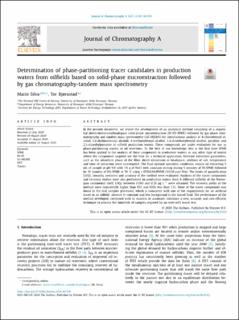| dc.contributor.author | Silva, Mario | |
| dc.contributor.author | Bjørnstad, Tor | |
| dc.date.accessioned | 2020-09-06T17:52:16Z | |
| dc.date.available | 2020-09-06T17:52:16Z | |
| dc.date.created | 2020-08-24T09:16:32Z | |
| dc.date.issued | 2020-08 | |
| dc.identifier.citation | Silva, M., Bjørnstad, T. (2020) Determination of phase-partitioning tracer candidates in production waters from oilfields based on solid-phase microextraction followed by gas chromatography-tandem mass spectrometry. Journal of Chromatography A, 1629. | en_US |
| dc.identifier.issn | 0021-9673 | |
| dc.identifier.uri | https://hdl.handle.net/11250/2676504 | |
| dc.description.abstract | In the present document, we report the development of an analytical method consisting of a sequential direct-immersion/headspace solid-phase microextraction (DI-HS-SPME) followed by gas-phase chromatography and tandem mass spectrometry (GC-MS/MS) for simultaneous analysis of 4-chlorobenzyl alcohol, 2,6-dichlorobenzyl alcohol, 4-methoxybenzyl alcohol, 3,4-dimethoxybenzyl alcohol, pyridine, and 2,3-dimethylpyrazine in oilfield production waters. These compounds are under evaluation for use as phase-partitioning tracers in oil reservoirs. To the best of our knowledge, this is the first time SPME has been applied to the analysis of these compounds in production waters, or any other type of matrix where the compounds targeted are the base for a technical application. Relevant extraction parameters, such as the adsorbent phase of the fiber, direct immersion or headspace, addition of salt, temperature and time of extraction were investigated. The final optimal operation conditions consist on extracting 5 mL of sample at pH 9.0 with 1.8 g of NaCl with constant stirring during 5 minutes of DI-SPME followed by 15 minutes of HS-SPME at 70 °C using a DVB/CAR/PDMS (50/30 µm) fiber. The limits of quantification (LOQ), linearity, precision and accuracy of the method were evaluated. Analyses of the tracer compounds and recovery studies were also performed on production waters from 8 different oilfields of the Norwegian continental shelf. LOQs between 0.080 and 0.35 µg L−1 were obtained. The recovery yields of the method were consistently higher than 85% and RSDs less than 13%. None of the tracer compounds was found in the real samples processed, which is consistent with one of the requirements for an artificial tracer in an oilfield: absence or constant and low background in the traced fluid. The performance of the method developed, combined with its easiness to automate, introduce a new, accurate and cost-efficient technique to process the hundreds of samples required by an inter-well tracer test. | en_US |
| dc.language.iso | eng | en_US |
| dc.publisher | Elsevier Ltd. | en_US |
| dc.rights | Navngivelse 4.0 Internasjonal | * |
| dc.rights.uri | http://creativecommons.org/licenses/by/4.0/deed.no | * |
| dc.subject | petroleumsteknologi | en_US |
| dc.title | Determination of phase-partitioning tracer candidates in production waters from oilfields based on solid-phase microextraction followed by gas chromatography-tandem mass spectrometry | en_US |
| dc.type | Peer reviewed | en_US |
| dc.type | Journal article | en_US |
| dc.description.version | publishedVersion | en_US |
| dc.rights.holder | © 2020 The Authors | en_US |
| dc.subject.nsi | VDP::Teknologi: 500::Berg‑ og petroleumsfag: 510::Petroleumsteknologi: 512 | en_US |
| dc.source.pagenumber | 9 | en_US |
| dc.source.volume | 1629 | en_US |
| dc.source.journal | Journal of Chromatography A | en_US |
| dc.identifier.doi | 10.1016/j.chroma.2020.461508 | |
| dc.identifier.cristin | 1824709 | |
| dc.relation.project | Norges forskningsråd: 230303 | en_US |
| cristin.ispublished | true | |
| cristin.fulltext | original | |
| cristin.qualitycode | 2 | |

